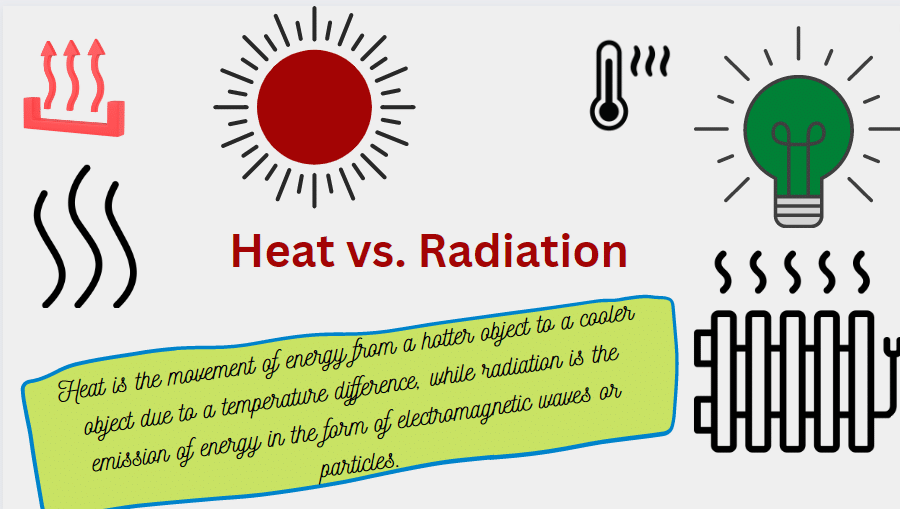Heat can be transferred in three ways: conduction, radiation, and convection.
Conduction refers to the transfer of energy via the movement of particles in contact with one another.
In technical terms, conduction is the transfer of heat energy through collisions between neighboring atoms or molecules. Conduction occurs more easily in solids and liquids because the particles are closer together than in gases. After all, the particles are further apart. Ironing a piece of clothing is an example of a conduction process in which heat is transferred to the clothing by a hot iron.

Table of Contents
Conduction Examples
- Heating a pan on a stove
- Heat transfers into your hands as you hold a hot cup of coffee.
- Touching a hot iron is an example of conduction.
- Hot coffee heats a paper cup by conduction.
- Ironing a piece of clothing
- Heat transfer through the solid walls of a refrigerated store
The Process of Conduction
Conduction is the transfer of heat energy through solids. Moving particles in a warm solid material can increase the heat energy of particles in a cooler solid material by transferring it directly from one particle to the next. Solids conduct heat better than liquids or gases because the particles are closer together.
In simple words, conduction is the direct exchange of molecular energy from hotter to cooler regions, with molecules with more energy communicating some of this energy to molecules with less energy.
Types of conduction
Following are the three types of the conduction phenomenon:
a. Electric Conduction
The capacity of a substance to conduct an electric current is referred to as electric conduction. The conductivity of an object is determined by the density of the object in relation to the strength of the electric field it can maintain.
- Metals have a high level of conductivity (also known as a conductor) because they have a low resistance to an electrical charge.
- Insulators are materials that resist electrical charges, such as glass and wood.
b. Heat Conduction
In heat conduction, The thermal energy is transferred within a stationary object as a result of a change in temperature in parts of a material adjacent to one another. Please check an interesting topic “Thermal conductivity of water”.
- The rate and direction of temperature change from one location to another is referred to as the temperature gradient.
- Diamonds, silver, gold, and copper are materials with high thermal conductivity.
c. Photoconductivity
Photoconductivity occurs when a material absorbs electromagnetic radiation, causing a change in the electrical conductivity of the substance.
- When an electromagnetic event happens, the number of free electrons and electron holes rises, enhancing the object’s electrical conductivity.
- Photoconductivity is used in a variety of applications, including copy machines, solar panels, and infrared detecting devices.
Daily Life Examples of Conduction
- A blacksmith heating up a sword in hot coals.
- Heat transfers into your hands as you hold a hot cup of coffee.
- Touching a hot seatbelt when you get into a car.
- Ice cools down your hand.
- boiling water by thrusting a red-hot piece of iron into it.
- When you touch a hot pan, heat is transferred from the pan to your hand through conduction.
- When you walk on a hot pavement, heat is transferred from the pavement to the soles of your feet through conduction.
- When you iron clothes, the heat is transferred from the iron to the fabric through conduction, which helps to remove wrinkles.
- When you boil water in a pot, the heat from the stove is transferred to the pot through conduction, which then transfers to the water.
- When you use a space heater to heat a room, the heat is transferred to the air through conduction, which then circulates throughout the room.
- When you hold an ice cube in your hand, heat is transferred from your hand to the ice through conduction, causing it to melt.
- When you cook food in a frying pan, the heat is transferred from the pan to the food through conduction.
- When you use a hot water bottle to warm up, heat is transferred from the bottle to your body through conduction.
Thermal Conductivity
Thermal conductivity is defined as the ability of a material to conduct or transfer heat energy. It is generally denoted by the symbol ‘k’. The reciprocal of thermal conductivity is known as thermal resistivity. Materials with high thermal conductivity are used in heat sinks, whereas materials with low values of λ are used as thermal insulators.
In the case of heat conduction, the equation, rate of heat transfer = driving force/resistance can be applied directly. The driving force is the temperature difference per unit length of the heat transfer path, also known as the temperature gradient. The resistance to heat flow is the reciprocal of the conductance.
dQ/dt = k A dT/dx
where dQ/dt is the rate of heat transfer, the quantity of heat energy transferred per unit of time, A
is the area of cross-section of the heat flow path, dT/dx is the temperature gradient, that is the rate
of change of temperature per unit length of the path, and k is the thermal conductivity of the
medium.
k (thermal conductivity) = dQ/dt x 1/A x 1/(dT/dx) (Jm-1s-1 oC-1)
Thermal Conductivity of Different Materials
- Thermal conductivity of Water: 0.7 Jm-1s-1 oC-1
- Ice: 2.3 Jm-1s-1 oC-1
- Air: 0.024 Jm-1s-1 oC-1
- Rubber: 0.03 – 0.06 Jm-1s-1 oC-1
Electrical Conduction in Metals
Metal conductivity is a measure of a material’s capacity to carry heat or electricity. Resistance, or the ability to reduce the flow of those, is the inverse of conductivity.
Metals conduct electricity by allowing electrons to travel freely between atoms. These electrons are not linked to any atom or covalent bond. Since like charges repel each other, moving one free electron within the lattice dislodges those in the next atom, and the process is repeated — moving in the direction of the current, toward the positively charged end.
However, the presence of impurities in most metals inhibits the passage of electrons. When compared to pure metals, elements added as alloying agents could be deemed “impurities.” As a result, alloys have lower electrical conductivity than the pure metal.
Summary
- Heat transfer is a dynamic process in which heat is spontaneously transferred from one body to another that is cooler.
- Conduction is the transfer of heat energy through collisions between neighboring atoms or molecules.
- Thermal conductivity is the ability of a material to conduct/transfer heat energy.
Conclusion
Heat is transferred in solids by conduction, in fluids by conduction and convection.
Heat transfer by radiation occurs through open space, can often be neglected, and is most
significant when temperature differences are substantial.
More Interesting Topics
What is Internal Energy?| Chemistry
Thermal Conductivity of Water
Energy Density| Short Overview
Relativistic Kinetic Energy| Easy Explanation
Heat Flux-An Overview
Absolute Temperature Definition| Kelvin Scale
Frequently Asked Questions
1. Heat capacity of water?
Heat capacity is the amount of heat energy required to raise the temperature of a given mass of a material by one unit. Water has a relatively high specific heat capacity of 4200 J kg -1 K-1, while copper has a specific heat capacity of 400 J kg -1 K -1.
2. What is the thermal energy equation?
The thermal energy equation is given as:
Q = mcΔT
Q: heat energy/thermal energy
m: mass
c: specific heat capacity
ΔT: change in temperature
3. What is the heat of fusion water?
Water has a heat of fusion of roughly 334 joules (79.7 calories) per gram at 0 degrees Celsius, and a heat of vaporization of approximately 2,230 joules (533 calories) per gram at 100 degrees Celsius.
4. kinetic energy of water molecules?
The greater the measured temperature, the more kinetic energy a molecule possesses as it travels quicker. The average speed of the water molecules in water at ambient temperature (20 °C or 68 °F) is around 590 m/s (1300 mph). However, this is simply the water molecules’ average (or mean) speed.
5. Is thermal energy potential or kinetic?
Thermal energy is simply another name for heat energy. It is both potential and kinetic energy.
Thermal potential energy is potential energy at the atomic and molecular levels, where it may be converted to kinetic energy or other types of energy. Chemical bonds, electrostatic or intermolecular interactions, and nuclear bonds are all examples of thermal potential energy.
Pistons in a steam engine extract thermal energy from hot gases. The steam engine then converts thermal energy into kinetic energy by using these rotating pistons to power whatever it is connected to.
6. Is boiling water an example of conduction?
Boiling water is a combination of conduction and convection. Conduction transfers heat from the heat source to the water at the bottom of the container, whereas convection transfers the heat inside the water.
More Interesting Topics
Thermal Diffusivity
Thermite Welding- An Overview
Specific Heat Formula & Concept
Specific Heat of Air
Quarks in Physics
Light Energy| Definition, and Properties
- BCl3 Lewis Structure in four simple steps - November 1, 2023
- PH3 Lewis Structure in four simple steps - October 8, 2023
- PF3 Lewis structure in four simple steps - September 24, 2023



